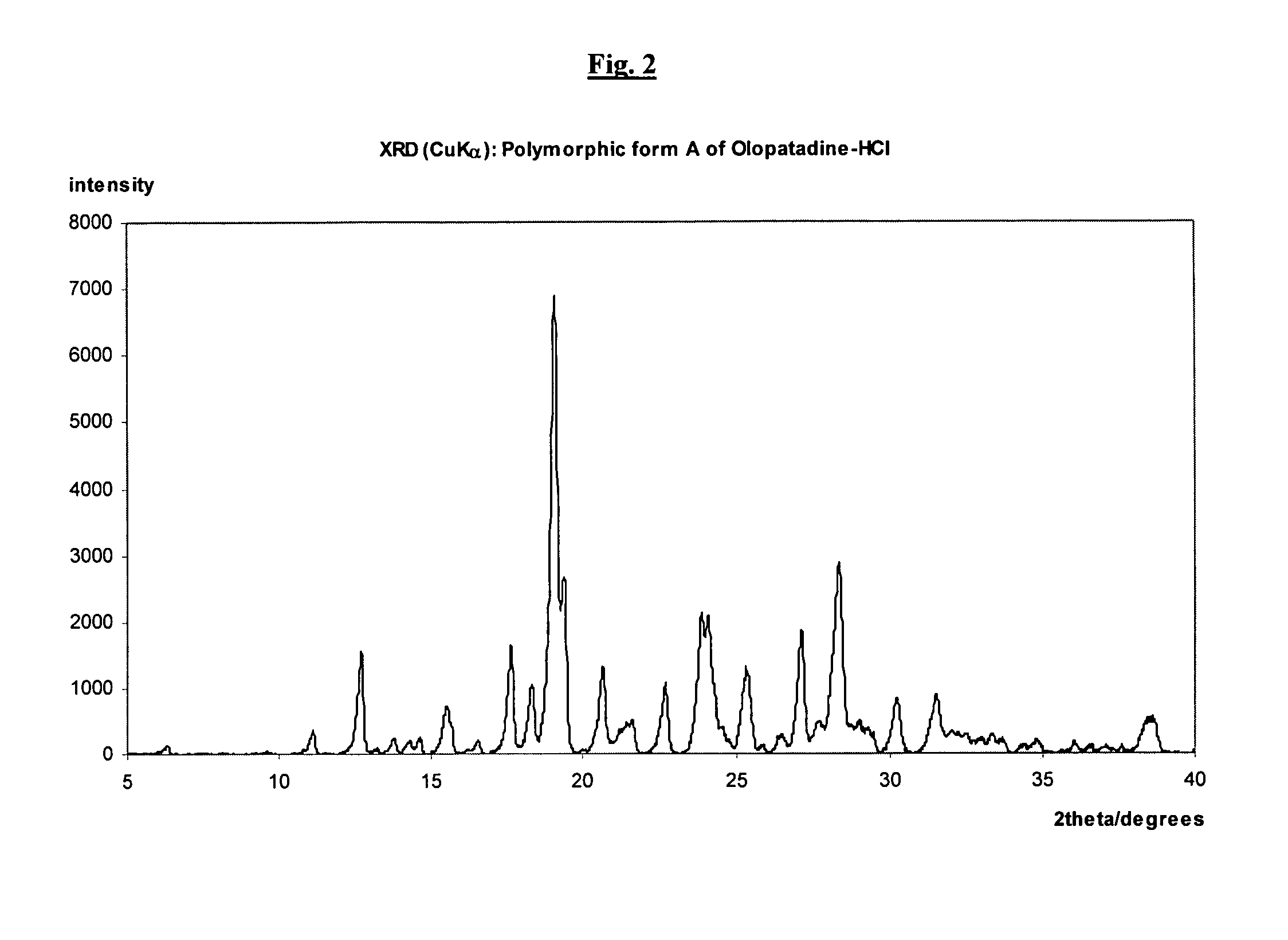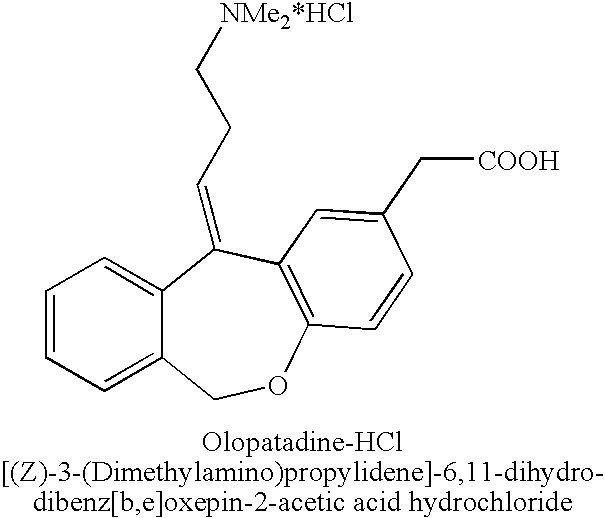Polymorphic forms of olopatadine hydrochloride and methods for producing olopatadine and salts thereof
- Summary
- Abstract
- Description
- Claims
- Application Information
AI Technical Summary
Benefits of technology
Problems solved by technology
Method used
Image
Examples
example 1
Synthesis of the Intermediate 4-(2-Carboxybenzyloxy)Phenylacetic Acid (Olo-IM1)
[0150]A solution of 4-hydroxyphenylacetic acid (90.0 g, 0.58 mol; assay >98%) and phthalide (85.07 g, 0.63 mol) in DMF (323 g) was heated to an internal temperature of 130° C. The pressure was reduced to 800 mbar and sodium methoxide (224.6 g, 1.25 mol, assay: 30% methanolic solution) was added slowly to the mixture maintaining the internal temperature above 100° C. During the addition methanol was distilled off, and after the addition the distillation was continued under normal pressure until the internal temperature increased to 130° C. again (260 g distillate). After stirring at this temperature for 6.5 h, phthalide (8.5 g, 0.06 mol) was added and the mixture was stirred overnight (16 h). Afterwards the mixture was cooled to 100° C. and hydrolyzed with water (1040 g). After cooling to <10° C., the pH of the mixture was adjusted to pH 1 with hydrochloric acid (163.5 g, 1.43 mol; assay: 32%). The product...
example 2
Synthesis of the Intermediate 6,11-dihydro-11-oxo-dibenz[b,e]oxepin-2-acetic acid (Olo-IM2)
[0152]To a suspension of 4-(2-carboxybenzyloxy)phenylacetic acid (Olo-IM1) (300.09 g, 1.04 mol; assay: 99.0%) and trifluoromethane sulfonic acid (4.77 g, 0.03 mol; assay: 98.0%) in toluene (1122 g) was added slowly trifluoroacetic anhydride (255.18 g, 1.20 mol; assay: 99.0%) at 20-35° C. The brown solution was stirred after complete addition of trifluoroacetic anhydride for 1 hour at 20-25° C. and the mixture was then hydrolyzed with water (99.0 g). Afterwards, the mixture was distilled under normal pressure until the steam temperature was 105-110° C. (1191 g two-phase distillate). The residue was diluted with toluene (261 g) and the suspension was heated to reflux. The dark solution was then cooled to 75° C. and seeded with crystals of 6,11-dihydro-11-oxo-dibenz[b,e]oxepin-2-acetic acid (Olo-IM2). The suspension was stirred after cooling to 20-25° C. for additional 1-2 hours at this temperatu...
example 3
Synthesis of the Intermediate 3-bromopropyltriphenylphosphonium bromide (Olo-IM3)
[0153]To a stirred solution of triphenylphosphine (511 g, 1.85 mol; assay: 95.0%) in toluene (800 g), 1,3-dibromopropane (371 g, 1.82 mol; assay: 99.0%) was added slowly within 1 hour at <5° C. After complete addition the solution was heated to reflux for 17 hours whereupon a suspension was obtained which was then cooled to room temperature. The product was filtered off at 20° C., washed with toluene (2×800 g) and dried under vacuum (21 h, 60° C.) to give 3-bromopropyltriphenylphosphonium bromide (Olo-IM3) as a white, crystalline solid (yield: 757 g, 1.63 mol, 89.6%).
PUM
| Property | Measurement | Unit |
|---|---|---|
| pH | aaaaa | aaaaa |
| pH | aaaaa | aaaaa |
| pH | aaaaa | aaaaa |
Abstract
Description
Claims
Application Information
 Login to View More
Login to View More - R&D
- Intellectual Property
- Life Sciences
- Materials
- Tech Scout
- Unparalleled Data Quality
- Higher Quality Content
- 60% Fewer Hallucinations
Browse by: Latest US Patents, China's latest patents, Technical Efficacy Thesaurus, Application Domain, Technology Topic, Popular Technical Reports.
© 2025 PatSnap. All rights reserved.Legal|Privacy policy|Modern Slavery Act Transparency Statement|Sitemap|About US| Contact US: help@patsnap.com



